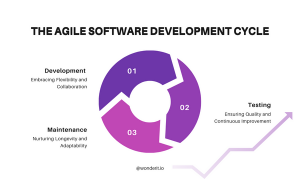Discover the transformative potential of agile software development and how it can revolutionise your business processes. Learn the key principles and the benefits of implementing agile methodologies.
In the quickly changing world of software development, organisations seek methodologies that enable them to stay ahead of the curve, adapt to changing requirements, and deliver high-quality products efficiently. Agile software development has emerged as a powerful approach that addresses these needs, allowing teams to embrace flexibility, collaboration, and continuous improvement. In this article, we will explore the fundamentals of agile software development, its benefits, and provide valuable insights on implementing this methodology successfully.
Understanding Agile Software Development
Agile software development refers to a set of principles and practices aimed at delivering software incrementally, with a focus on flexibility, collaboration, and rapid response to change. Unlike traditional waterfall approaches, where the entire project is planned upfront, agile development embraces iterative cycles, allowing teams to adjust and adapt as they progress.
The Agile Manifesto, a foundational document for agile methodologies, emphasises four core values:
- Individuals and interactions over processes and tools
- Working software over comprehensive documentation
- Customer collaboration over contract negotiation
- Responding to change over following a plan.
These values prioritise the importance of people, working solutions, customer involvement, and adaptability. By adhering to these principles, agile teams can achieve greater customer satisfaction, faster time to market, and increased project success rates.
Benefits of Agile Software Development
Enhanced Collaboration:
Agile methodologies foster regular communication and collaboration among team members, stakeholders, and customers. This promotes shared understanding, alignment of goals, and timely feedback, resulting in improved teamwork and a better end product.
Adaptability to Change:
Agile embraces change as a natural part of software development. By breaking down projects into smaller iterations or sprints, teams can quickly respond to evolving requirements, market dynamics, or customer feedback, ensuring that the final product aligns with the most current needs.
Faster Time to Market:
Agile methodologies enable rapid delivery of working software increments. By focusing on delivering tangible value in each iteration, organisations can release functional features earlier, gaining a competitive edge and validating their assumptions sooner.
Higher Product Quality:
Agile places a strong emphasis on continuous integration, testing, and customer feedback. This iterative feedback loop allows teams to detect and address issues earlier in the development cycle, resulting in higher-quality software and reduced post-release defects.
Improved Customer Satisfaction:
By involving customers in the development process, agile methodologies ensure that their needs are understood and incorporated. This customer-centric approach enhances satisfaction, as customers feel engaged and receive software that better aligns with their expectations.
Statistics on Agile Software Development
According to a recent survey conducted by the Project Management Institute (PMI), organisations that adopt agile methodologies experience:
28% higher project success rates compared to non-agile organisations. (Source: PMI Agile Practice Guide);
25% faster time-to-market for new products and features. (Source: VersionOne State of Agile Report);
30% improvement in team productivity and employee engagement. (Source: Harvard Business Review).
These statistics highlight the significant benefits that organisations can achieve by adopting agile software development practices.
The Agile Software Development Cycle
Development: Embracing Flexibility and Collaboration
Agile software development emphasises incremental and iterative development, allowing teams to adjust and adapt as they progress. Unlike traditional waterfall approaches, where the entire project is planned upfront, agile development breaks down projects into smaller iterations or sprints. This approach facilitates collaboration, empowers developers to make informed decisions, and ensures that the software aligns with evolving requirements. By embracing flexibility and collaboration, agile development enables teams to deliver working software increments efficiently and effectively.
Testing: Ensuring Quality and Continuous Improvement
Quality assurance plays a vital role in agile software development. Testing is integrated throughout the development process, ensuring that software meets the highest standards. Agile teams embrace continuous testing, identifying and addressing issues early on. Test-driven development (TDD) is a popular practice where tests are written before the code, fostering a focus on expected behaviour. This iterative feedback loop, combined with frequent customer involvement, helps improve the quality of the software and reduces post-release defects. By embedding testing within each iteration, agile teams ensure the delivery of high-quality software that meets customer expectations.
Maintenance: Nurturing Longevity and Adaptability
Agile software development recognises that software maintenance is an ongoing process. Beyond the initial development and release, agile teams continue to maintain and enhance the software based on feedback and evolving needs. The iterative nature of agile allows for continuous improvement and the incorporation of new features or bug fixes. Agile teams prioritise maintenance tasks through a product backlog, ensuring efforts are aligned with the most valuable areas. By nurturing the longevity and adaptability of the software, agile methodologies enable organisations to respond to change effectively and deliver long-term value to their customers.
By leveraging agile software development, organisations can revolutionise their business processes, achieving enhanced collaboration, faster time to market, higher product quality, and improved customer satisfaction. Statistics from reputable sources highlight the significant benefits that organisations can experience by adopting agile practices.
The Agile software development cycle is a highly iterative and flexible approach to software development that focuses on delivering working software in short, frequent increments. It emphasises collaboration, adaptability, and customer satisfaction. The Agile methodology allows teams to respond quickly to changes and feedback, enabling them to deliver high-quality software that meets customer needs.
The agile software development cycle, with methodologies such as Scrum, Kanban, Extreme Programming (XP), Lean Software Development, and Feature-Driven Development (FDD), provides frameworks for development, testing, and maintenance. Choosing the right methodology based on project characteristics is crucial for successful implementation.

Here are some of the most popular Agile methodologies:
Scrum: Scrum is one of the most widely used Agile frameworks. It divides the project into short iterations called sprints, typically lasting 1-4 weeks. Scrum teams work in cross-functional units and have daily stand-up meetings to discuss progress and plan the day’s work. The product backlog, a prioritised list of features, is managed by the product owner, and the team selects a subset of items to work on in each sprint.
Kanban: Kanban is a visual framework that focuses on continuous delivery and workflow optimization. It uses a board with columns to represent different stages of the development process, such as “To Do,” “In Progress,” and “Done.” Each work item is represented by a card, and the team limits the number of items in each column to avoid overloading. Kanban provides a real-time view of the project’s status and encourages teams to optimise their workflow continuously.
Extreme Programming (XP): XP emphasises close collaboration between developers and customers. It promotes frequent communication, continuous testing, and short development cycles. XP practices include test-driven development (TDD), pair programming, and frequent code refactoring. XP teams focus on delivering high-quality software by continuously integrating code and providing rapid feedback.
Lean Software Development: Lean principles focus on eliminating waste and maximising customer value. It emphasises the efficient use of resources, reducing cycle time, and continuous improvement. Lean software development incorporates concepts from lean manufacturing, such as value stream mapping and minimising inventory (in the form of work in progress). It aims to deliver software faster and with fewer defects.
Feature-Driven Development (FDD): FDD is an iterative and incremental Agile methodology that emphasises a feature-centric approach to software development. It begins with an overall model of the system and then breaks it down into a list of features. Each feature goes through a sequence of steps, including domain walkthrough, design, code, and inspection. FDD encourages regular feedback and frequent releases.
These are just a few examples of Agile methodologies, and there are others like Crystal, Dynamic Systems Development Method (DSDM), and Adaptive Software Development (ASD). Each methodology has its unique strengths and is suitable for different types of projects. The key to successful Agile software development lies in selecting and tailoring the methodology to fit the specific needs and characteristics of the project, while embracing the Agile principles of collaboration, adaptability, and customer-centricity.
Conclusion
Agile software development has revolutionised the software industry by enabling organisations to be more responsive, adaptable, and customer-centric. Embracing agile methodologies empowers teams to deliver high-quality software efficiently, meet changing customer needs, and gain a competitive advantage.
Remember, successful implementation of agile software development requires a mindset shift, collaboration, and continuous improvement. By adhering to the core principles of agility, fostering a culture of trust and collaboration, and embracing a learning mindset, your organisation can unlock the full potential of agile methodologies.
Stay committed to the journey of agility, and your software development process will evolve into a powerful engine for innovation, efficiency, and customer satisfaction.
Are you ready to embark on the agile journey? Start today by contacting WonderIT and witness the transformative impact of agile software development on your organisation’s success.


Recent Comments